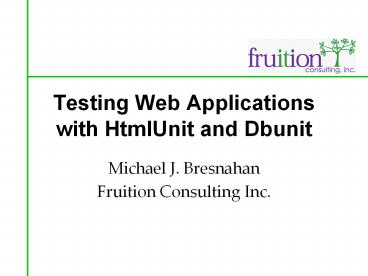Testing Web Applications with HtmlUnit and Dbunit - PowerPoint PPT Presentation
1 / 17
Title:
Testing Web Applications with HtmlUnit and Dbunit
Description:
Testing Web Applications with HtmlUnit and Dbunit. Michael J. Bresnahan. Fruition Consulting Inc. ... 1 year of HtmlUnit and Dbunit experience. A Brief ... – PowerPoint PPT presentation
Number of Views:681
Avg rating:3.0/5.0
Title: Testing Web Applications with HtmlUnit and Dbunit
1
Testing Web Applications with HtmlUnit and Dbunit
- Michael J. Bresnahan
- Fruition Consulting Inc.
2
Agenda
- About Me, Mike Bresnahan
- Brief Overview of HtmlUnit and Dbunit
- Benefits of Automated Testing
- About HtmlUnit
- About Dbunit
- Designing Tests
- Questions and Answers
3
About Me, Mike Bresnahan
- 9 years of software development experience
- Enterprise applications
- C, C, Java
- Relational Databases
- Client/Server
- Web
- 1 year of HtmlUnit and Dbunit experience
4
A Brief Overview of HtmlUnit and Dbunit
- Both are Java APIs for automated functional
testing. - HtmlUnit is a Java API for automated testing of
web applications. - Dbunit is a JUnit extension for automated testing
of database applications. - Both are Java APIs, but can be used to test
applications written in any language. - Both are Open Source.
5
Benefits of Automated Testing
- More efficient than manual testing.
- Less error prone than manual testing.
- Enables collective code ownership.
- Enables refactoring.
- Enables frequent integration.
6
About HtmlUnit
HtmlUnit Test Client
Web Server
Application Server
7
HtmlUnit Features
- HTTP 1.0 and 1.1
- HTTPS
- HTML 4
- Cookies
- Proxy Servers
- JavaScript
- Simulated Mouse Clicks
- DOM Search and Navigation
8
Simple HtmlUnit Test
- 1 public class SimpleHtmlUnitTest extends
junit.framework.TestCase - 2
- 3 public void testHomePage() throws
Exception - 4 WebClient webClient new WebClient()
- 5 java.net.URL url new
- 6 java.net.URL("http//htmlunit.sourc
eforge.net") - 7
- 8 HtmlPage page (HtmlPage)
webClient.getPage(url) - 9
- 10 assertEquals("Welcome to HtmlUnit",
page.getTitleText()) - 11
- 12
9
HTML Form Test
- 1 public class FormTest extends
junit.framework.TestCase - 2
- 3 public void testForm() throws Exception
- 4 WebClient webClient new WebClient()
- 5 java.net.URL url
- 6 new java.net.URL("http//htmlunit.sou
rceforge.net") - 7
- 8 HtmlPage page (HtmlPage)webClient.getP
age(url) - 9
- 10 HtmlForm form page.getFormByName("myfo
rm") - 11
- 12 HtmlTextInput textInput
- 13 (HtmlTextInput)form.getInputByName("
myfield") - 14
- 15 textInput.setValueAttribute("zappa zoo
yeah!") - 16
- 17 form.submit()
- 18
- 19
10
Button Click Test
- 1 public class ButtonClickTest extends
junit.framework.TestCase - 2
- 3 public void testButtonClick() throws
Exception - 4 WebClient webClient new WebClient()
- 5 java.net.URL url
- 6 new java.net.URL("http//htmlunit.
sourceforge.net") - 7
- 8 HtmlPage page (HtmlPage)
webClient.getPage(url) - 9
- 10 HtmlForm form page.getFormByName("myf
orm") - 11
- 12 HtmlButtonInput buttonInput
- 13 (HtmlButtonInput)
form.getInputByName("mybutton") - 14
- 15 HtmlPage newPage (HtmlPage)buttonInpu
t.click() - 16
- 17
11
About Dbunit
XML
Database
12
Dbunit Features
- DTD database schemas
- Import/export XML datasets
- Manipulate datasets
- Compare datasets
- Ant task
13
Abstract Database Test
- 1 public abstract class AbstractDatabaseTestCase
- 2 extends org.dbunit.DatabaseTestCase
- 3
- 4 protected IDatabaseConnection
getConnection() throws Exception - 5 java.sql.Connection connection
java.sql.DriverManager. - 6 getConnection("jdbcoraclethin_at_loc
alhost1521foo") - 7 return new DatabaseConnection(connection
) - 8
- 9
- 10 protected DatabaseOperation
getSetUpOperation() throws Exception - 11 return DatabaseOperation.CLEAN_INSERT
- 12
- 13
- 14 protected IDataSet getDataSet() throws
Exception - 15 return new FlatXmlDataSet(new
java.io.File("dataset.xml")) - 16
- 17
14
Dataset.xml
- lt!DOCTYPE dataset SYSTEM "dataset.dtd"gt
- ltdatasetgt
- ltSTUDY_SESSIONS ID"1" AIMR_AREAS_ID"1"
STUDY_SESSION_CODE"1/gt - ltSTUDY_SESSIONS ID"2" AIMR_AREAS_ID"1"
STUDY_SESSION_CODE"2/gt - ltREADINGS ID"1" STUDY_SESSIONS_ID"1"
READING_CODE"1"/gt - ltREADINGS ID"2" STUDY_SESSIONS_ID"2"
READING_CODE"2"/gt - lt/datasetgt
15
Simple Dbunit Test
- 1 public void test() throws Exception
- 2
- 3 // exercise the application
- 4
- 5 IDataSet expectedDataSet
- 6 new FlatXmlDataSet(new
java.io.File("expected.xml")) - 7
- 8 ITable expectedTable expectedDataSet.get
Table(readings") - 9
- 10 ITable databaseTable getConnection().
- 11 createQueryTable(readings","select
from readings") - 12
- 13 Assertion.assertEquals(expectedTable,
databaseTable) - 14
16
Designing Tests
- Keep tests independent
- Keep tests small and single purpose
- Pool database connections
- Load common reference data once
- Engineer the test suite
- Decouple tests from the application as much as
possible - Use Dbunit to hold the expected data of web pages
17
Further Reading
- http//htmlunit.sf.net
- http//dbunit.sf.net
- http//junit.org































